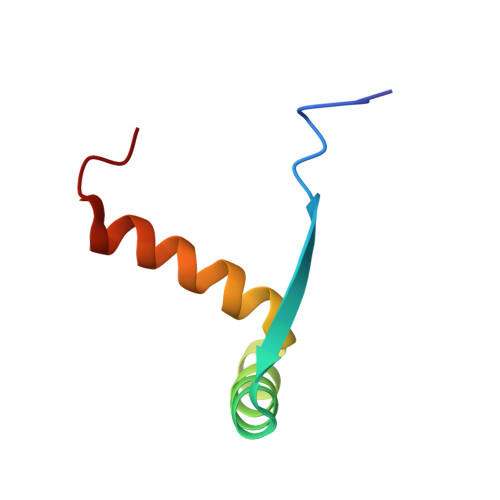Structure-Based Stability Analysis of an Extremely Stable Dimeric DNA Binding Protein from Sulfolobus islandicus
Weininger, U., Zeeb, M., Neumann, P., Low, C., Stubbs, M.T., Lipps, G., Balbach, J.(2009) Biochemistry 48: 10030-10037
- PubMed: 19788170
- DOI: https://doi.org/10.1021/bi900760n
- Primary Citation of Related Structures:
2K9I, 3FT7 - PubMed Abstract:
ORF56 is a small and thermodynamically extremely stable dimeric protein from the archaeon Sulfolobus islandicus. This DNA binding protein is encoded on plasmid pRN1 and possibly controls the copy number of the plasmid. We report the solution NMR structure as well as the crystal structure of ORF56 comprising a ribbon-helix-helix fold. The homodimer consists of an antiparallel intersubunit beta-sheet and two alpha-helices per monomer, which is a common DNA binding fold of plasmid- and phage-encoded gene regulation proteins. NMR titration experiments with ORF56 and double-stranded DNA derived from its promoter binding site revealed that it is largely the beta-sheets that interact with the DNA. The beta-sheet experiences high local fluctuations, which are conserved among DNA binding ribbon-helix-helix dimers from mesophilic and hyperthermophilic organisms. In contrast, residues strongly protected against H-D exchange are localized in helix 2, forming the hydrophobic intermolecular core of the dimer. A structure-based comparison of the intermolecular binding surface and the change in accessible surface area upon unfolding of various ribbon-helix-helix dimers with the Gibbs free energy changes and m values show a correlation between hydrophobicity of these surface areas and stability. These findings provide possible explanations for the very high thermodynamic stability of ORF56 with retained DNA binding capacity.
Organizational Affiliation:
Institut fur Physik, Biophysik, Martin-Luther-Universitat Halle-Wittenberg, D-06120 Halle (Saale), Germany.














